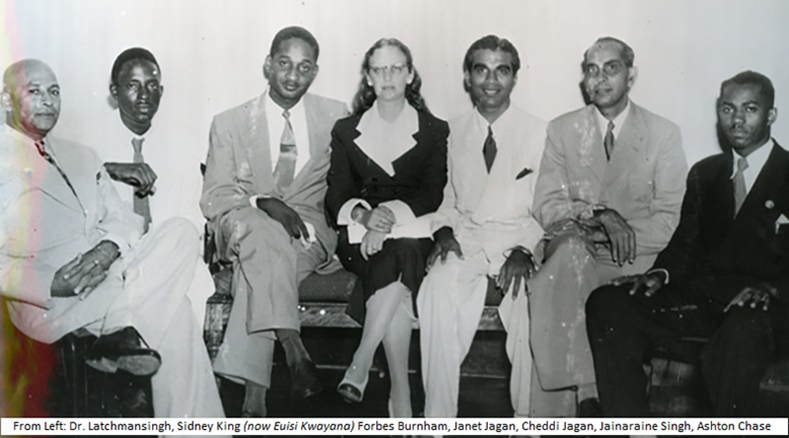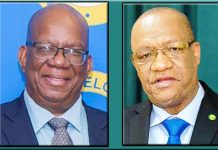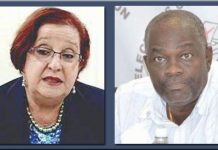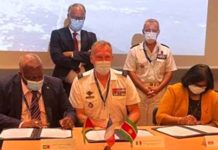The Constitution is the supreme law of Guyana. It outlines the branches and powers of Government, establishes qualifications and times for elections, lists basic human rights and sets up independent institutions to protect these rights. All laws made by Parliament must be in keeping with the provisions of the Constitution. This means that any law that is in conflict with the Constitution is unconstitutional, in other words, it is not valid……
….. Early in 1999 an Act of Parliament established the Constitutional Reform Commission. It successfully completed its tasks and submitted its report to the National Assembly by the due date of 17th July, 1999. The Commission made 171 recommendations for constitutional amendments. All amendments, with the exception of those requiring a referendum, have been passed into Acts of Parliament.
…The first paragraph is the introduction to the Nation’s Constitution …..
Maybe it’s my untrained legal mind that read it like a paradoxical metaphor …. the Constitution is the law… the law is the Constitution…any law conflicting the constitution is unconstitutional…
…which posed the question, when was the last time “We the people of the Cooperative Republic of Guyana” read the constitution, understanding its influence over our day to day existence…even seeing what it says and particularly of late?
It’s not enough to acknowledge constitutional illiteracy with a mere shrug of nonchalance. This is the one document that defines our national identity. Its place in our cultural heritage, citing the six peoples of our nation and the bond of nationality that yields one people, one nation with one destiny, is patently unique. Its values are what bind us together as a nation, not race nor ethnicity or culture; not politics or party.
We are Guyanese because of a shared belief system enshrined in this Constitution; a structured document that phases into its parts, through a Preamble that started with “We the People of the Cooperative Republic of Guyana” then detailed the reason why it is ‘We the people’, why we have a Constitution at all, why we became a Republic, and in succinct language, defined the powers of the government as originating from the people.
The Preamble was, thus, the integrative part of this document of national franchise, connecting the terms of the social contract in language that was more descriptive than ornate to its legally binding portion. Its carefully selected verbiage, therefore, was no arbitrary choice of words but was intended to help us understand the Constitution as a whole, in its intent, basic meaning and fundamental tenets.
And here’s what else it did.
It announced itself as the voice of the people with a shared history…
It told us the story.
It was born of struggle and determination through intrepid engagements with British Colonizers by those who will forever be known as the foundation of Independent Guyana…with the founding of the Political Affairs Committee in 1946 by Cheddi and Janet Jagan and its evolution into the People’s Progressive Party around 1950- both being bodies that attracted a multi ethnic combination of British Guiana’s finest minds…Euisi Kwayana then Sydney King , Forbes Burnham, Sheila La Taste, Clinton Wong, Hubert Nathaniel Critchlow, Rudy Luck, Rory Westmaas, Ashton Chase, Martin Carter, Winifred Gaskin…to name a few.
But…
In spite of this, it was not without its internal turmoil, views that didn’t exactly line up with the Jagans’ …evidenced by Dr. Joseph P. Lachmansingh’s expulsion for attempting to form his own Labor Party and his re-admission a few months later.
Then came the ultimate fracture, that of Forbes Burnham who went on to form the PNC, then a coalition with Peter D’Aguiar- an alternative to the PPP that the West preferred.
Now, the fight for Independence was coming from two camps – the PPP which had declared itself Communist and the PNC/UF, with the former taken as mildly socialist and latter, Capitalist.
That the campaign for Independence continued amidst acrimony is captured in this description UK Hansard 1964 para above 100: The only difference now is that instead of Dr. Jagan sitting tight and Mr. Burnham gnashing his teeth, Mr. Burnham sits tight whilst Dr. Jagan gnashes his teeth…in reference to the 1961 bicameral Legislature …Jagan now having to share decision making with his opposing team.
Because the details are voluminous and fall outside the scope of what’s being discussed here, it will be sufficient to state the fact that upon declaration of Independence in 1966 the Constitution implemented was a modification of its 1961 predecessor (below 1136 Mr. Fisher) and that, in spite of declaration of Cooperative Republic status in 1970 the 1966 Constitution remained the operational machine, with its core parts as it had been under the previous ones, being that of a ‘democracy operating under the rule of law’.
It is this history of turmoil, discord, the contemplations of a Colonist Parliament dealing with Cheddi ’s declaration as a Communist, their assessment of Janet as a clever, ruthless, Communist, their Cautious preference of Forbes whom they saw as a “ …very effective leader..has a first class brain” and their confidence in D’Auguiar only to the extent that he was co leader with Forbes, that gave us the home grown Preamble with a punctilious selection of language to color the journey. …
…and its arrival in the 1980 Constitution, crafted for the first time by Guyanese…some well-known stalwarts… whose struggles yielded this measure of progress.
And though the 1980 Constitution became an instrument that was fiercely opposed by PPP on claims of ‘entrenchment of power’, defended with an oral craft and biopsied like a lawyer with a surgeon’s license to show that it had international precedent, by Forbes Burnham and passed by partisan majority, the one unquestioned, untouched portion was its Preamble, which recounted the nation’s history… not the least of which was: ACKNOWLEDGING our common purpose of national cohesion and our common destiny as one people and one nation … to explain the content that followed.
Then, in 1999, seven years after the PPP’s ascension to office, a Constitution Reform Committee was assented to by Janet Jagan, successor of Cheddi Jagan and appointer of Bharat Jagdeo, in an obvious line of hand picked leadership. Ironically, the parts of the ‘strongman’ 1980 Constitution they vowed to gut once given the chance, provided cover for a series of questionable political skirmishes employed by said Party; one of which installed Janet as President …which questions whether the delay in addressing an issue that gave them so much angst was a tactical political maneuver for self-reward…Cheddi having accomplished a series of specific actions in his five year tenure …which we’ll touch on shortly.
It was an atmosphere of ‘Our Turn Now’.
Constitution reform became the mission of politics. The authoritarianism once condemned became the wheelhouse of power. Authority was more important than legitimacy. The center of power had to be commandeered…
And it is the Janet’s leg of this political relay that brings us to the Preamble….
In reviewing the Constitution Reform Act of 1999, it is important to note part 6.2.1 and its mission to “provide for the current and future rights, duties, liabilities and obligations, of the Guyanese people; and for that purpose shall receive, consider and evaluate submissions for the alteration of the Constitution; and report its recommendations to the Special Select Committee for transmission to the National Assembly”.
We followed the instruction and read it in consonance with the prescribed readings, all of which stood firmly with executing governance for one people, one nation and one destiny.
But there was a tone of over- instruction that made us curious and in searching, we found some history that may not be as widely known as it should be…that was somehow patented for political gain and infused into this Constitution which should be the People’s Contract…as in ALL the people.
See, while the fight for Independence was being waged primarily by Cheddi Jagan and Forbes Burnham, Stephen Campbell, an Amerindian from Santa Rosa of the North West District was just as actively fighting but- to preserve the lands he felt were the exclusive property of Amerindians only.
Colin Palmer’s ‘Cheddi Jagan and the politics of Power’ (p. 205 -206) adds an exclamation point to this period in Guyana’s history…
It details the words of 1958 American Consul, General Melby who recounts: ….Stephen Campbell admitted that there was historical “antipathy, hostility between Africans and Amerindians dating back to “when his people served as slave catchers”. Amerindians, said Campbell, voted as a racial group and having to choose between the black man, the white man and the coolie man….preferred the white man because he was the “known factor”. Campbell…. showed a “lower opinion of the African”, disdaining those who were “more English than the English” and expressed admiration for the economic proficiency of the Indian.
By deduction, this set up the perfect ally for the PPP to expand its predominantly East Indian base.
This little known history notes that Stephen Campbell (block 574) attended the British Guiana 1962, 1963 and 1965 Independence Conferences in Britain to make his plea (letters that can be read here 245-254) which resulted in part of Guyana’s Independence Agreement being Amerindian Land Rights. The Amerindian Land Commission was formed under the leadership of Forbes Burnham in 1966 and by 1969 it recommended that 24000 (pg 13 top) of the 43000 square miles claimed by the Amerindians be issued to them.
It would be good to note, right here, that Guyana is 83000 square miles which meant that the Amerindian claim was for more than half of that. And though their lands were taken from them by a succession of invaders, their claim to more than half of Guyana came at a time when five other races were its occupants; one, the African race, uprooted from various countries in Africa and brought there- to replace Amerindian labor that the ‘white man’ found to be too weak – bound in chains and forced to work those very lands, dig and build every foundational structure, under conditions that were physically brutal, emotionally destabilizing shaping a psychology of achievement-challenge that became the sad inheritance of generations ….shaping… the antipathy, hostility, of Stephen Campbell towards Africans, even as he recalled them as people running for their lives and his people as slave catchers – of the fleeing negroes….
It is this history that helps us understand the political calculus of Cheddi Jagan’s Presidency; his declaring of Stephen Campbell as a National Hero in 1993, his creation of a first of its kind Ministry of Amerindian Affairs to which he appointed Vibert De Souza in 1993 and his declaring of September as Amerindian month in 1995- begging the question when, during his stewardship in years 1953 – 1964 had he made any bold overtures for Amerindians.
The attempt to attract the Amerindian vote was unvarnished.
Constitution reform would be its manifestation.
The twenty eight years that the Jagans had to sit on the sidelines of politics gave them time to think of where they were and where they wanted to be.
They were once the fabric of the country’s politics, founding members of its political machine which attracted a rich cross section of the nation’s sociocultural element.
Loss of confidence in Cheddi’s vision was partially caused by his inability to empathize-even politically- with other races because he was so inherently East Indian. …to which letters from Colonial Secretary William Leslie Heape 1947/8 back to England expressing anxieties about a ‘subversive’ Cheddi, then President of the British Guiana East Indian Association – an organization that was founded upon the doctrine of East Indian Ascendance circa 1916… would attest.
He was back now, no longer an icon of leadership, having demonstrably succumbed to too many of its challenges.
Now it was a game of numbers.
Janet Jagan’s Constitution reform Act of 1999 started the Reform Committee that produced the GUYANA ACT No. 6 of 2001 CONSTITUTION (AMENDMENT) (No. 4) ACT 2001 assented to by Bharat Jagdeo who by then had been ‘Knighted’ President in the succession of leadership that seemed so carefully orchestrated after the 1992 win by Cheddi through the convenient retainment of a Constitution that he had decried as dictatorial…
…which brings us back to the sanctity of the Preamble (scroll to preamble) a scrupulously eloquent arrangement of words that, with progression, laid out the 12 steps to arriving at the intended goal of the Constitution, considering at each step, commitment to national cohesion, destiny as one nation, one people.
GUYANA ACT No. 6 of 2001 CONSTITUTION (AMENDMENT) (No. 4) ACT 2001 assented to by Bharrat Jagdeo is an act that boasts Repeal and Re-enactment of the Preamble of the Constitution…
There is inexplicable economy of expression in this rendition (scroll to preamble) of such a critical portion of this significant document…the exegesis of which could be interpreted as lack of reverence, if it were not so obvious that lack of dexterity in our official language is the culprit here.
Without making this an English Lesson or an exercise in literary appreciation, “We the People of the Cooperative Republic of Guyana” and “We the Guyanese People” are distinctly different – with the latter merely describing our nationality, while the former, with the preposition ‘of’, gives us ownership; etches ‘we the people’ deeply into our national consciousness, simultaneously invoking collective national pride….for starters.
And, there’s usually a reason for linguistic richness. It employs a range of figures of speech and every part of speech to stimulate imagination and convey a message.
On the flip side, one way to assess a writer’s intent in an informational text is to study choices made during revisions — which words are deleted and what is selected to replace them.
Bharrat Jagdeo’s gutted Preamble does two things that prove intent.
It deprives us of the labored and historic journey to Independence.
And …..of supreme importance
It inserts:
(We) Value the special place in our nation of the Indigenous Peoples and recognise their right as citizens to land and security and to their promulgation of policies for their communities…
…which contradicts our motto and asserts that the Indigenous People hold a place that is higher than the other five races…
This has been assented to since 2001 and has been sitting in a Constitution that is a contract with everyone….not a partisan slice of the nation.
Indeed, there was a Constitution reform committee that assented to this but that assent was made in a unicameral house with a partisan agenda and with not enough public information or public representation.
The refashioning of the Preamble to insert a salutation to one race is racism and contradicts every response to racism submitted on the 2014 Office of the United Nations High Commissioner for Human Rights questionnaire.
The Constitution is the Supreme law of Guyana.
This amendment, in essence, makes racism law.
Politicians tend to retain the parts of the apparatus that rot in their favor.
Political Manifestos, of every Party, overtly court this, Indigenous, demographic subscribing to its separateness and creating a classism that perpetuates the very division that the Constitution and Motto outlaw.
This is rot that is now gangrenous and should not be retained by any government succeeding one that deployed this relatively surreptitious effort to change the Nation’s Constitution for partisan gain.
We’re not sure what the Coalition reform suggestions submitted to the Prime Minister are but in the interest of retaining our values, upholding our motto and extending the appreciation, dignity and respect that is the inheritance of each race, we ask that this amendment, the one that singles out one race from amongst six, to ‘value and recognize’, be reviewed for pertinence to what we, as a nation, proclaim.






leaving a comment to test